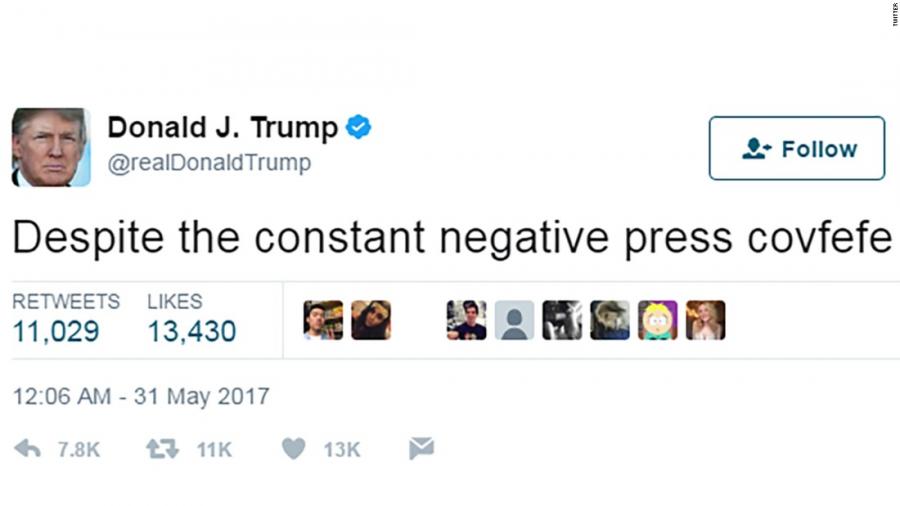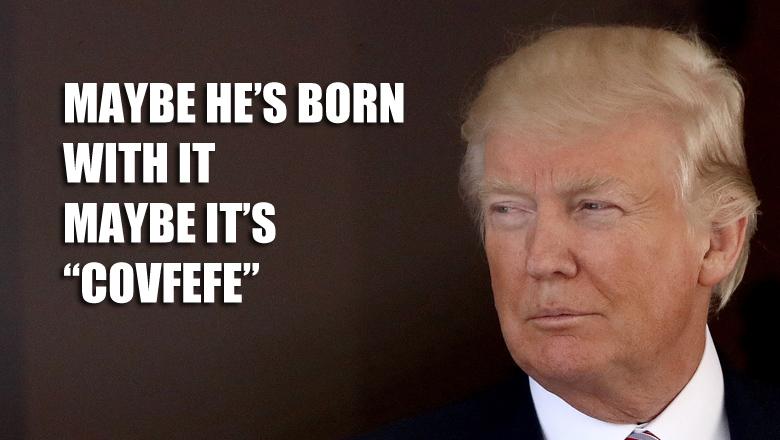
"Covfefe" may have exposed a secret Trump language
The immediate attention and quick rise of "covfefe", along with the press secretary's remark, provokes the question: was it just a typo? Or the exposure of a linguistic community of practice and knowledge?
Variation is an existing phenomenon in every language. It spans across time and space, as well as many social factors such as gender, ethnicity, and class. Sociolinguists favor the idea that non-standard language isn’t wrong, it’s just another form, or variety, of a language. However, the mainstream population is resistant to accept this idea. Any deviation from the language 'norm' is at high risk of being noticed and thus marked as incorrect (Van Herk, 2012).
So, when President Donald Trump incorporated a new word, “covfefe”, into his Twitter repertoire, people took notice.
The tweet (pictured above), published on May 31,2017 at 12:06 AM, was left up for 6 hours before being taken down. Most folks will chalk it up to a typo and laugh it off, attributing it to Trump’s ignorance and carelessness.
What is most noteworthy here is the sheer speed with which “covfefe” and this half-sentence came into the limelight. Within one day, many major news platforms had grabbed the information and published stories about it. And now, just two days after the incident took media stage, and the one-word Google search provides multiple pages of hits, including a covfefe designated wikipedia page that is already available. It quickly became an internet sensation and it was reproduced in various and comical ways such as creation of “Make American Covfefe Again” merchandise and seen (via meme) in a Wheel-of-Fortune puzzle.
Covfefe memes and hashtags quickly gained presence online
For strict standard-variety users, however, it was not so funny. An immense stigma associated with the unusual lexicon and incomplete sentence arose. Reporters and news broadcasters were flabbergasted that the president of the United States, “the leader of the free world”, could have made such a mistake, and condemned the word misuse as unacceptable. They began to discuss the anomaly as an indicator to a “bigger problem”.
The incident became relevant in terms of sociolinguistics after Sean Spicer’s comment in a press conference: “The president and a small group of people know exactly what he meant.” Taking his words at face-value, he insinuates that there may in fact be a community of practice at play. Van Herk (2012) states that “a ‘community of practice’ is characterized by mutual engagement, a jointly negotiated enterprise, and a shared repertoire.” Perhaps Spicer hints to the public that the Trump administration, or even the whole republican party, make up their own speech community! It could be that within the oval office, they are using a covfefe of different words and covfefing to the covfefers amongst covfefes. The president may have been acting as a broker, trying to bring his speech community's variant to mainstream standard English. Until his May 31st tweet, Trump’s group probably chose to remain in linguistic isolation, for one reason or another. But, alas! Sean Spicer has exposed them. And it is only a matter of time before their shared linguistic features are recognized, marked, and associated with prestige or (more plausibly) stigma.
Most likely just a typo, it is still interesting to look at the incident through a sociolinguistic lens. Apart from Spicer's suggestion of a secret Trump-administration language community, "covfefe" did indeed generate a new community of practice (and knowledge) with the many millions of people who have appropriated and toyed with it. And all in all, the debut word made a strong impact, and will no doubt be used for many Trump jokes to come.
Reference
Van Herk, G. (2012). What is sociolinguistics. Chichester, West Sussex, UK: Wiley-Blackwell.

